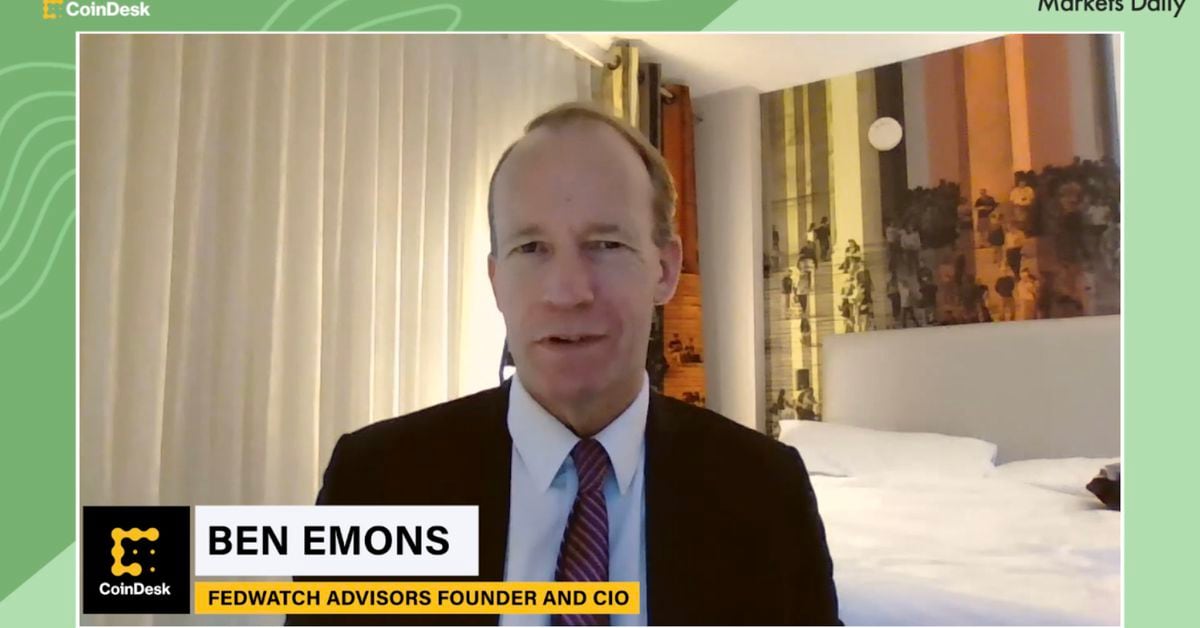Regulation
What Cooling Inflation Means for the Cryptocurrency Market | Video

Good morning and happy Tuesday, it’s July 11th, another day. Another episode of Markets Daily. Thanks for listening. As always, we have a lot to tell our guests today. But first, a quick update on prices and what’s happened so far this morning because we just got a new CP I reading at 8:30 AM Eastern time that showed inflation has fallen to 3%, which is lower than expected. So, great news for the market and Bitcoin jumped about half a percent on the news and is up 2.22% in the last 24 hours to trade at $59,000. Fetcher Powell also continued his week of appearances on Capitol Hill yesterday and said among other things that the Fed will not wait for inflation to return to 2% to start cutting rates. He also said that interest rates will not go back down to near zero, like they were before the pandemic. So it looks like we could maybe see a rate cut or two this year after all. But let’s react and more to all of that with our guests today, who is Ben Emmons, founder and CIO of Fed Watch Advisors. Good morning, Ben. Good morning. Thanks for having us. Sure, Ben. What do you think about today’s reading of the CP I report? Yeah, as you said, it’s a good report. It shows that this inflation that we’re talking about, right? It’s the month-over-month decline in inflation. Which is really on track now. It’s not accelerating, but it’s on a good footing. And I think that’s good for the Federal Reserve. As you also said, the Fed is not going to wait for this number to actually hit 2% and we’re getting close to that. So that means that for the Fed, this rate cut decision is getting close as well, but it’s still going to be a little bit of a mixed bag in September. I don’t think I saw the possibility of September changing too much yet, but yields are definitely coming down in reaction to this number. What’s important here is that, not only was the stock down, there’s a lot of energy effect there, but it’s really the underlying number that, that’s come down a little bit lower. And that’s because the rent component that ultimately shows a further deceleration. That’s really good news because that’s where the problems have been concentrated in inflation, rigid rents and then some of the services aspects of CP I. So let’s take it all together. I say it’s, fortunately it’s a good number. Again, it’s the third good number after the first three bad numbers that we had earlier in the year. So getting, you know, at least neutralizing the trend from the beginning of the year. So hopefully the next few numbers will be good as well. Either way, I think it’s a good day for the market. Now, I just said earlier that Fed Chair Powell said that the Fed is not going to wait for inflation to get back to 2% to start cutting rates. 3% seems pretty close considering where we’re coming from. So is that a good place to start cutting rates? Maybe not in September, but maybe, you know, later in the year? Yeah, I think that’s what the market is doing, this September cut is happening because a party, I think the technicalities that are going on in the futures markets, but you really look at the cumulative number of cuts that are really pricing in, it actually starts in December. And so I think that’s the path that the Fed has a little bit of time here to say, hey, we’re really driving inflation in the direction that we wanted and it’s really working in our favor, so to speak. So, you know, you’re getting a little bit of a repeat of what I wrote in my note this morning. You know what that reminds me of is, it’s 2015. That was, by the way, a bad year for markets. But what it was really about was this heightened speculation that when, with the high Gras at that time and even then, everybody was focused on September and saying, well, they’re going to do it and they ultimately didn’t do it without caution and decided to do it in December. It looks a little bit similar to today. You know, what was interesting at the time is that October was a huge risk in the ring markets when the Fed finally gave forward guidance to the market saying we’re not ready to cut rates. And that, I think is still missing here for the markets today. This number is not going to immediately give Powell the reason to give us forward guidance, which is to say, okay, that’s a good number. We’re going to cut rates in September. He, he, he delayed yesterday and I don’t think he would change his mind, uh, today even on these numbers because they just show that he’s on track, but we’re not there yet, right? So, as you said, we’re at 3% and not 2%, right? It’s interesting that you bring that up because now CP I and the unemployment report are obviously the two most relevant economic reports that the Fed looks at, but there are a lot of other indicators for the state of the economy and some of them have been, you know, pretty weak in the last few weeks. So how much can we really, you know, listen to what Powell is saying instead of looking at the actual data and that’s where the economy is because it’s been out for some time that the forward-looking indicators, the leading indicators are all pointing to this weakness and it’s made, you know, commentators cautious if not very scared that we’re already in a recession and we’re not careful enough to tighten too much and then we’re going to end up in a really bad recession. And that hasn’t really played out partly because I think again, the idea of looking forward is based only on surveys and certain indicators that by definition are more forward-looking, they’re not necessarily always forward-looking. Right. Right. Because just as interest rate expectations have been wrong for many years, you know what the Fed has ultimately delivered in terms of high rates or cuts. So I think it’s really the more hard data like AC PI like a payroll report like the jobless claims this morning, the notable droppers are down again to 222,000, the lowest in, I think the last four or five weeks, you’re still emphasizing like this is a labor market that’s cooling but not really deteriorating. That’s the hard data. I think that’s what matters a little bit more than these forward-looking indicators, even though they’re not wrong, but they tend to overextend. And so I think as an investor, I say, I kind of take this hard data and I look at the trend in the hard data. And what that tells me from CB I today is we had two bad prints at the beginning of the year. We’re getting two good prints, three good prints back. So my trend is flat. So I might say, OK, if the next number comes out better than expected, like weaker, so to speak, then maybe you could say this rate because it’s close right now. Going back to Powell’s words for a second, the market, including cryptocurrencies, has reacted positively to Powell’s remarks this week, it’s the market here in taking his words as a bullish indicator to some extent because, you know, he was cautious and he, he didn’t want to give us any guidance as I said. But I think what they’re, what they’re taking away from this is that he, you know, these words about the models for the advance of inflation and the significant cooling of the labor market. Those kind of modest and significant words are for the markets to say, wow, you wouldn’t say words like that if you weren’t closer in your mind to a decision, right? When you’re going to cut the rate, I think that’s all this, this kind of fat part of the game as we call it. Uh You know, and I think that’s why the markets are latching onto those words. I just started to get back as you said, you know, risk on markets like Bitcoin or, or, ol’ S and P 500. Yeah, it benefits because what we, what those markets are doing is just pricing in for when the Fed actually cuts rates. And that just drives those prices up. I would say on the other hand that, those interest rates like in Treasury yields would be pretty capped but not like the lower end of the range anymore, we haven’t seen a significant move down in yields yet. And that’s because including today’s number is disinflationary, but it’s not like saying we’re going to go into a deflationary environment with really low inflation. It’s not about the data that they say. So, um, I think the markets are taking power at their word. They still want to see several months of data before they actually make that decision. Is that, is that a takeaway? Now the Fed has two mandates like, as you know, better than I do. Um, it’s keeping inflation low and labor market strong between those two right now. What would you say? The Fed is mostly focused on or or what is their priority right now? I think there is still uh uh inflation as the highest priority because the labor market is coming into equilibrium and that’s the wording that they’ve been using for the last six months or so. And that’s it. And just seeing payroll growth moderate further and seeing these unemployment claims rise a little bit and the employment rate rise a little bit and it’s really driven by labor supply because of all the immigration influx into the labor market that has actually added net supply of workers. And that’s led to this cooling trend. So they’re looking at that said as if it’s a normal healthy pattern in the labor market that was really hot and steamy before and as a result, wage increases are kind of moderating. But the inflation numbers, so they’re with these reports in the minutes that were also highlighted as slow progress, right? They made good progress last year and then they stalled and slowed down and got a little bit worrisome and maybe we’re back on track now, but we’re not, we’re still making slow progress. And I think that’s why it makes them cautious, like if it’s that slow, can we make some quick moves here on rates, you know, they want to cut rates. I think that’s not a problem on the Fed’s part, but it’s really about making sure that they’re actually at the right time or at the right time that they can because if they don’t, there’s a concern that they’re, you know, actually making the wrong decision at the wrong time and letting things heat up again and get overinflated, right. So the slow progress is, I think that’s why they’re focused on the demand inflation side. Right. Well, I think today’s report was definitely a step in the right direction. Uh, thank you, Ben, for coming on the show. Thank you, Elena. It was great to be here. Thank you. That was Ben Emmons, founder and CEO of Fet Watch Advisors. Thanks for tuning in today.
Regulation
Cryptocurrency Regulation in Slovenia 2024

Slovenia, a small but highly developed European country with a population of 2.1 million, boasts a rich industrial history that has contributed significantly to its robust economy. As the most economically developed Slavic nation, Slovenia has grown steadily since adopting the euro in 2007. Its openness to innovation has been a key factor in its success in the industrial sector, making it a favorite destination for cryptocurrency enthusiasts. Many believe that Slovenia is poised to become a powerful fintech hub in Europe. But does its current cryptocurrency regulatory framework support such aspirations?
Let’s explore Slovenia’s cryptocurrency regulations and see if they can push the country to the forefront of the cryptocurrency scene. My expectations are positive. What are yours? Before we answer, let’s dig deeper.
1. Cryptocurrency Regulation in Slovenia: An Overview
Slovenia is known for its pro-innovation stance, providing a supportive environment for emerging technologies such as blockchain and cryptocurrencies. Under the Payment Services and Systems Act, cryptocurrencies are classified as virtual assets rather than financial or monetary instruments.
Regulation of the cryptocurrency sector in Slovenia is decentralized. Different authorities manage different aspects of the ecosystem. For example, the Bank of Slovenia and the Securities Market Agency supervise cryptocurrency transactions to ensure compliance with financial laws, including anti-money laundering (AML) and counter-terrorist financing regulations. The Slovenian Act on the Prevention of Money Laundering and Terrorist Financing (ZPPDFT-2) incorporates the EU’s Fifth Anti-Money Laundering Directive (5MLD) and aligns with the latest FATF recommendations. All virtual currency service providers must register with the Office of the Republic of Slovenia.
2. Cryptocurrency regulation in Slovenia: what’s new?
This year, there have been several noteworthy developments in the cryptocurrency sector in Slovenia:
July 25, 2024: Slovenia has issued a €30 million on-chain sovereign digital bond, the first of its kind in the EU, with a yield of 3.65%, maturing on 25 November 2024.
May 14, 2024: NiceHash has announced the first Slovenian Bitcoin-focused conference, NiceHashX, scheduled for November 8-9 in Maribor.
3. Explanation of the legal framework for cryptocurrency taxation in Slovenia
Slovenia’s cryptocurrency tax framework provides clear guidelines for both individuals and businesses. According to the Slovenian Tax Administration, tax treatment depends on the status of the trader and the nature of the transaction.
- Individuals: Income earned from cryptocurrencies through employment or ongoing business activities is subject to personal income tax. However, capital gains from trading or market fluctuations are exempt from taxation.
- Society: Capital gains from cryptocurrency activities are subject to a corporate income tax of 19%. Value added tax (VAT) generally applies at a rate of 22%, although cryptocurrency transactions considered as means of payment are exempt from VAT. Companies are not allowed to limit payment methods to cryptocurrencies only. Tokens issued during ICOs must comply with standard accounting rules and the Corporate Tax Act.
4. Cryptocurrency Mining in Slovenia: What You Should Know
Cryptocurrency mining is not restricted in Slovenia, but the income from mining is considered business income and is therefore taxable. This includes rewards from validating transactions and any additional income from mining operations. Both natural persons and legal entities must comply with Slovenian tax regulations.
5. Timeline of the evolution of cryptocurrency regulations in Slovenia
Here is a timeline highlighting the evolution of cryptocurrency regulations in Slovenia:
- 2013:The Slovenian Tax Administration has issued guidelines according to which income from cryptocurrency transactions should be taxed.
- 2017:The Slovenian Tax Administration has provided more detailed guidelines on cryptocurrency taxation, based on factors such as the trader’s status and the type of transaction.
- 2023The EU has adopted the Markets in Cryptocurrencies Regulation (MiCA), which establishes a uniform regulatory framework for cryptocurrencies, their issuers and service providers across the EU.
Final note
Slovenia’s approach to the cryptocurrency industry is commendable, reflecting its optimistic view of the future of cryptocurrency. The country’s balanced regulatory framework supports cryptocurrency innovation while protecting user rights and preventing illegal activities. Recent developments demonstrate Slovenia’s commitment to continuously improving its regulatory environment. Slovenia’s cryptocurrency regulatory framework sets a positive example for other nations navigating the evolving cryptocurrency landscape.
Read also: Cryptocurrency Regulation in Hong Kong 2024
Regulation
A Blank Slate for Cryptocurrencies: Kamala Harris’ Regulatory Opportunity

Photo by The Dhage of Shubham ON Disinfect
As the cryptocurrency landscape continues to evolve, the need for clear regulation has never been greater.
Vice President Kamala Harris is now leading the charge on digital asset regulation in the United States, presenting a unique opportunity for a clean slate. This fresh start can foster innovation and protect consumers. It can also pave the way for widespread adoption across industries, including real estate agencies, healthcare providers, and online gambling platforms like these online casinos in the uk. According to experts at SafestCasinoSites, these platforms have advantages such as bonus offers, a wide selection of games, and various payment methods. Ultimately, all this increased adoption could push the cryptocurrency market forward.
With that in mind, let’s take a look at the current state of cryptocurrency regulation in the United States, which is a complex and confusing landscape. Multiple agencies, including the Securities and Exchange Commission (SEC), the Commodity Futures Trading Commission (CFTC), and the Financial Crimes Enforcement Network (FinCEN), have overlapping jurisdictions, creating a fragmented regulatory environment. This lack of clarity has hindered innovation, as companies are reluctant to invest in the United States, fearing regulatory repercussions. A cohesive and clear regulatory framework is urgently needed to unlock the full potential of cryptocurrencies in the United States.
While the US struggles to find its footing, other countries, such as Singapore and the UK, are actively embracing the cryptocurrency industry with clear and supportive regulatory frameworks. This has led to a brain drain, with companies opting to set up in more hospitable environments.
Vice President Kamala Harris has a unique opportunity to change this narrative and clean up the future. cryptocurrency regulation. By taking a comprehensive and inclusive approach, it can help create a framework that balances consumer protection with innovation and growth. The time has come for clear and effective regulation of cryptocurrencies in the United States.
Effective regulation of digital assets is essential to fostering a safe and innovative environment. Key principles guiding this regulation include clarity, innovation, global cooperation, consumer protection, and flexibility. Clear definitions and guidelines eliminate ambiguity, while encouraging experimentation and development to ensure progress. Collaboration with international partners establishes consistent standards, preventing regulatory arbitrage. Strong safeguards protect consumers from fraud and market abuse, and adaptability allows for evolution in response to emerging trends and technologies, striking a balance between innovation and protection.
The benefits of effective cryptocurrency regulation are many and far-reaching. By establishing clear guidelines, governments can attract investors and traditional users, spurring growth and adoption. This, in turn, can position countries like the United States as global leaders in financial technology and innovation. Strong protections will also increase consumer confidence in digital assets and related products, boosting economic activity.
A thriving cryptocurrency industry can significantly contribute to GDP and job creation, which has a positive impact on the overall economy. Furthermore, effective regulation has paved the way for the growth of many companies such as tech startups, online casinos, and pharmaceutical companies, proving that clear guidelines can unlock new opportunities without stifling innovation. This is a great example of how regulation can alleviate fears of regressive policies, even if Kamala Harris does not repeal the current progressive approach. By adopting effective regulation, governments can create fertile ground for the cryptocurrency industry to thrive, driving progress and prosperity.
Regulation
Think You Own Your Crypto? New UK Law Would Ensure It – DL News

- The UK Law Commission has developed a bill that will address a situation of legal uncertainty.
- The commission’s goal is to ensure that cryptocurrencies are legally treated as personal property.
UK law is not entirely clear whether cryptocurrencies can be considered personal property.
This is according to the UK Law Commission, which argues that while most investors assume that when they buy cryptocurrencies, they are “acquiring property rights in the same way as buying, say, a watch or a laptop.”
“As the law currently stands, this is not necessarily the case,” the respected legal body said in a new report on Tuesday.
The report was accompanied by a solution: a new bill to consolidate the legal status of digital assets as personal property.
This could be huge for the estimated 4.7 million Britons valued hold cryptocurrencies.
“This will allow the courts to determine a range of issues,” the report says.
If passed, the law would help clarify how cryptocurrencies are treated in cases of bankruptcy, estate planning or theft.
Flexible law
The commission is an independent body responsible for reviewing UK law. It began investigating whether English and Welsh property laws apply to digital assets in 2020.
Join the community to receive our latest stories and updates
At the time, then-Chancellor of the Exchequer Rishi Sunak expressed ambitions to transform the UK into a cryptocurrency hub as Britons invested more.
In 2023, the commission decided that, in most cases, the legislation of England and Wales is sufficiently flexible to regulate cryptocurrencies.
This means that any asset, from Bitcoin to non-fungible tokens and some types of digital contracts, can be considered personal property, without Parliament having to write extensive new laws.
There was one small area of uncertainty, however: it was unclear whether cryptocurrencies fell within the two categories of personal property recognised under UK law.
These two categories are made up of tangible assets (cars, laptops, bags) and intangible assets (contracts, stocks, and debt).
The bill that will now go to Parliament to be converted into law aims to remedy this situation.
Without that clarification, courts may try to lump cryptocurrencies together with intangible assets, said Adam Sanitt, head of litigation, knowledge, innovation and corporate support EMEA at law firm Norton Rose Fulbright. DL News in March.
This is problematic because intangible assets are creations of the legal system, while cryptocurrencies are not.
“How the law treats digital assets, what rights you have over them, how you own them, how you transfer them to other people—that treatment is different, because digital assets don’t exist by virtue of the legal system, but independently of it,” Sanitt said.
The money in your bank account, for example, is a legal creation. The government could pass a law to cancel it.
However, if the UK passed a law banning Bitcoin, Bitcoin would not cease to exist.
Sanitt said: “That’s why digital assets are so important: neither the government nor the legal system can take them away from you.”
Contact the author at joanna@dlnews.com.
Regulation
The Solution the Cryptocurrency Industry Needs

The cryptocurrency industry has performed remarkably well since its inception, but now faces a critical hurdle that requires careful consideration and regulatory expertise to overcome. Despite the industry’s rapid growth and rate of global adoption, the gap between the industry and global regulation is only widening as new innovations break through into the public domain.
Although efforts are being made on both sides, regulators’ lack of familiarity with cryptocurrencies and the industry’s lack of regulatory expertise are hindering innovation in the sector. To address this issue, traditional financial institutions (TradFi) such as MultiBank Group have started venturing into the cryptocurrency sector.
The regulatory gap
Over the past decade, the cryptocurrency industry has grown dramatically as tech entrepreneurs and forward-thinking thinkers have founded a plethora of crypto platforms and protocols to push the boundaries of the space. The problem faced by these newcomers, who are often unfamiliar with the hurdles posed by financial regulators, can quickly overwhelm and stall operations.
On the other hand, regulators more attuned to TradFi systems may be equally stifled by the complexities of decentralization and blockchain technology. The unfamiliarity experienced by both innovators and regulators creates a stark regulatory divide between both sides, leading to misunderstandings and potential conflicts.
To overcome this lack of communication, a bridge must be built to bridge the gap, ensuring future stability for the cryptocurrency industry and clearer legislation from regulators.
Efforts to bridge the gap between industry
The gap between the cryptocurrency industry and regulators is slowly narrowing as efforts to regulate cryptocurrencies and Web3 space activities are gaining momentum. Specific regulatory actions are taking place in many countries, aimed at providing greater oversight of cryptocurrency transactions, cryptocurrency exchanges, and initial coin offerings (ICOs).
Despite being a positive step in the right direction, these new regulations can differ significantly between jurisdictions around the world. This fragmentation results in a regulatory environment filled with obstacles, bottlenecks, and varying requirements and prohibitions. As cryptocurrency companies and TradFi institutions attempt to navigate the minefield, the regulatory maze becomes increasingly convoluted.
TradFi institutions like MultiBank Group are working to solve this problem, as one of the largest financial derivatives institutions in the world with over 12 licenses across all continents. Founded in 2005, the Group has an impeccable and trustworthy reputation globally, extensive expertise in financial regulation and has now ventured into the cryptocurrency space via MultiBank.io.
MultiBank.io: TradFi Excellence in the Crypto Space
Expanding into the cryptocurrency space via MultiBank.io has enabled MultiBank Group to provide regulatory clarity and trust to the digital asset industry. With a substantial daily trading volume of $12.1 billion, the timely decision to enter the cryptocurrency space has the potential to set regulatory precedents and standards for years to come.
By helping to develop sensible and well-considered regulations, MultiBank.io’s established reputation allows the company to communicate effectively and clearly with regulators. Unlike others in the industry without regulatory expertise, MultiBank.io facilitates the Group’s commitment to rigorous regulatory standards, the scope of oversight and establishes the necessary transparency.
The company’s approach ensures that regulatory licenses are pre-acquired, compliance is met globally without jurisdictional barriers, and transactions remain secure at all times. By helping to create robust regulations that are both clear and innovation-friendly, MultiBank Group looks forward to standardizing the entire cryptocurrency industry for other potential innovators.
One of the biggest challenges in establishing a clearly constructed bridge between regulators and the cryptocurrency industry is effective communication. By leveraging its institutional background TradFi and acting as an intermediary with regulators, MultiBank Group is able to translate the needs of the industry to those who shape it.
This quality of mediation is essential to ensure that regulation helps develop essential technological advances rather than hinders their establishment and growth. Through the lens of TradFi when looking at the complexity of the cryptocurrency industry, MultiBank Group is able to deconstruct unfamiliar crypto arguments for regulation and create a safer and more secure space.
Where TradFi and Crypto Meet
Regulations are crucial for traders, investors, and everyday users of crypto platforms and their safety when participating in crypto markets. While strict regulations are necessary for stable market integrity, innovation should still be considered, something MultiBank Group considers a priority.
Where TradFi and cryptocurrencies converge, the Group is there to provide a balanced approach to ensure promotion for both the cryptocurrency industry and regulators seeking to protect both retail and institutional investors. This balance is critical to maintaining a thriving space where cryptocurrency innovation can thrive without compromising the security of user funds or data.
As more TradFi institutions like MultiBank Group enter the cryptocurrency space with ever-expanding expertise in regulatory understanding, the future of the industry is increasingly encouraged. The financial freedoms of the cryptocurrency space coupled with regulatory oversight for financial security will be the guiding lights for the future success of the entire cryptocurrency industry.
No spam, no lies, just insights. You can unsubscribe at any time.
-

 Ethereum12 months ago
Ethereum12 months agoEthereum Posts First Consecutive Monthly Losses Since August 2023 on New ETFs
-

 Regulation12 months ago
Regulation12 months agoCryptocurrency Regulation in Slovenia 2024
-

 News12 months ago
News12 months agoNew bill pushes Department of Veterans Affairs to examine how blockchain can improve its work
-

 Regulation12 months ago
Regulation12 months agoThink You Own Your Crypto? New UK Law Would Ensure It – DL News
-

 Regulation12 months ago
Regulation12 months agoUpbit, Coinone, Bithumb Face New Fees Under South Korea’s Cryptocurrency Law
-

 Regulation12 months ago
Regulation12 months agoA Blank Slate for Cryptocurrencies: Kamala Harris’ Regulatory Opportunity
-

 Regulation12 months ago
Regulation12 months agoBahamas Passes Cryptocurrency Bill Designed to Prevent FTX, Terra Disasters
-

 Regulation12 months ago
Regulation12 months agoIndia to Follow G20 Policy for Cryptocurrency Regulation: MoS Finance
-

 News1 year ago
News1 year ago“Captain Tsubasa – RIVALS” launches on Oasys Blockchain
-

 Ethereum1 year ago
Ethereum1 year agoComment deux frères auraient dérobé 25 millions de dollars lors d’un braquage d’Ethereum de 12 secondes • The Register
-

 News12 months ago
News12 months agoEU supports 15 startups to fight online disinformation with blockchain
-

 News1 year ago
News1 year agoSolana ranks the fastest blockchain in the world, surpassing Ethereum, Polygon ⋆ ZyCrypto





